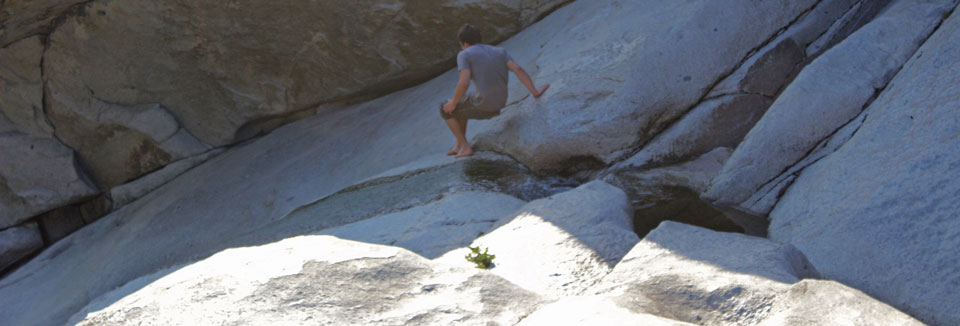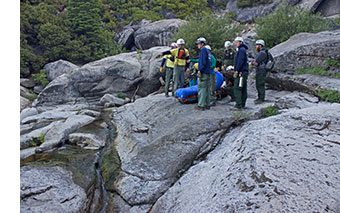
Photos by Colton Shires
On the evening of Friday, August 12, 2016, two young men were scrambling barefoot and off-trail near Chilnualna Falls in Wawona. While exploring, one of the men slipped on the water-polished granite and slid down the slope to the left of the falls. At first, the subject’s friend thought he was joking, until he heard the subject hit the ground. The subject’s friend quickly scrambled down and saw his friend mangled on the rocks. The subject was pale and limp. His friend began to systematically assess the situation, shaking the subject awake and finding that he was responsive but not alert. The subject’s friend then checked his ribs and the subject noted that his leg hurt. When the subject’s friend examined his leg, he knew the subject had a broken femur.
To call 911, the subject’s friend had to hike out about a mile to receive cell phone service. He was put in contact with a protection ranger, and relayed to her the findings of his assessment of the situation and examination of the subject. While the SAR team developed a plan, the subject’s friend returned to Chilnualna Falls and began to prepare for their arrival. First, he returned to where they set up camp for the night and gathered medical supplies, layers, and lights. He then attended to bleeding lacerations and tried to keep the subject awake and warm. When the sunlight started to fade, he set up the lights and set them to strobe mode, so the their location would be more obvious.
 The protection ranger, who was first to respond to the scene, was dropped off via helicopter a minute before pumpkin time. Pumpkin time is a half hour before sunrise and half hour after sunset, when the National Park Service does not fly helicopters. The protection ranger was able to provide the subject with more advanced medical care. She placed a traction splint on the subject’s right leg and placed the subject in a vacuum splint. A few hours after the protection ranger arrived, four Yosemite Search and Rescue team members arrived on scene. In the morning, the subject was airlifted out of the park.
The protection ranger, who was first to respond to the scene, was dropped off via helicopter a minute before pumpkin time. Pumpkin time is a half hour before sunrise and half hour after sunset, when the National Park Service does not fly helicopters. The protection ranger was able to provide the subject with more advanced medical care. She placed a traction splint on the subject’s right leg and placed the subject in a vacuum splint. A few hours after the protection ranger arrived, four Yosemite Search and Rescue team members arrived on scene. In the morning, the subject was airlifted out of the park.
Lessons Learned
-
Yosemite’s wilderness is not a controlled environment and has a required element of self sufficiency. The subject was a gymnast, martial artist, and had been trained in stunt falling. Despite the body awareness he gained from these activities, he now recognizes that these skills do not ensure he can safely scramble on polished granite. The subject notes, “No matter how comfortable you are, never underestimate nature. Keep in mind consequences—things happen so fast, don't become complacent.” The subject’s friend echoes his statement, sympathizing with visitors because it is easy to “lose sight of reality in the scale and awe of Yosemite,” but it is important to recognize the consequences.
-
Responses in the wilderness are not immediate. Providing detailed information to responders allows the team to respond in a more timely manner. The subject’s friend was able to provide the protection ranger with answers to all of her questions. This allowed her to determine how to evacuate the patient (by foot, horseback, or air) from the wilderness, what resources the reporting party had, and the patient’s condition and location. The protection ranger appreciated that the reporting party had collected his thoughts and spoke succinctly, did a basic assessment of injuries, and was calm. The subject’s friend attributes his calm demeanor and systematic approach to training he received as an open-water lifeguard. The subject’s friend remarks, “It was a 50/50 switch, break down and cry, or go help him.” He developed a plan and got help.
-
Despite having a head injury and broken femur, the subject stayed out overnight at the location of the accident. The protection ranger made this decision by weighing the various risk factors. She felt it was better to wait until morning to airlift him out instead of bumping him down a trail in a wheeled litter for four hours. Even though a response may be timely, evacuation of the subject from the scene may take a significant amount of time depending on the risk to rescuers or the subject.
-
The subject’s life was changed by the accident, but he has a positive outlook on events that occurred afterwards, stating, “My life changed for the better.” He now focuses on letting others know how quickly things can go south. When he reflects on the incident he notes, “[I was] on top of world, having the best time of my life, and then everything came crashing down.” A year after the incident, the subject and the subject’s friend hiked the trail to Chilnualna Falls with a healthy respect for Mother Nature.
